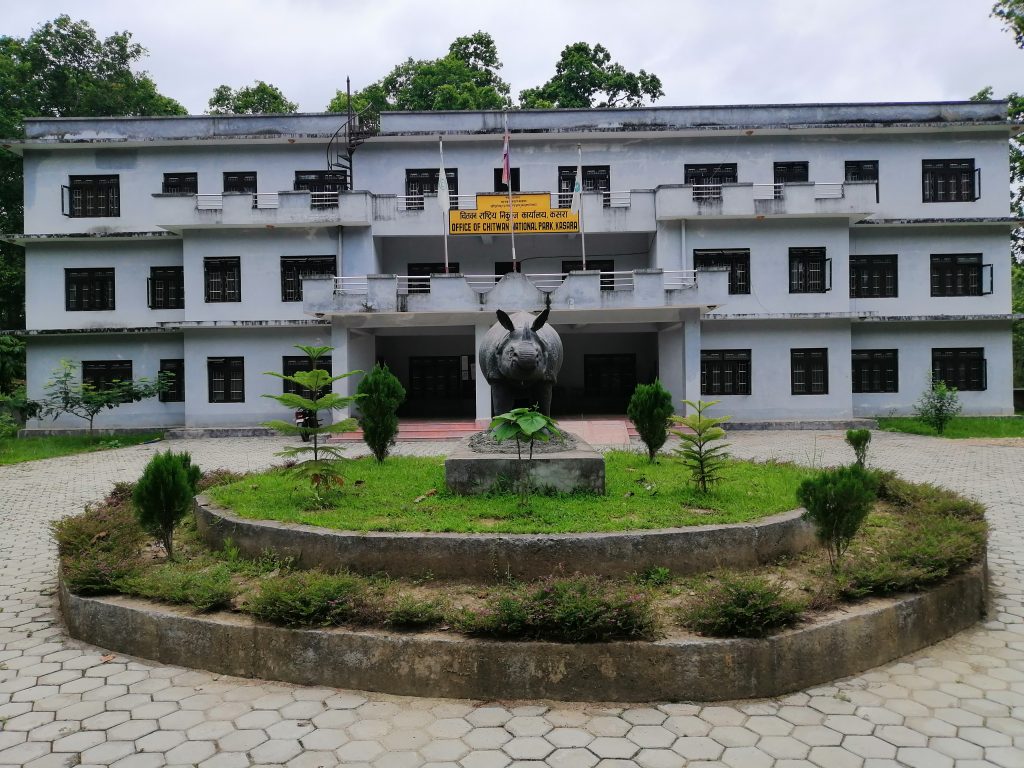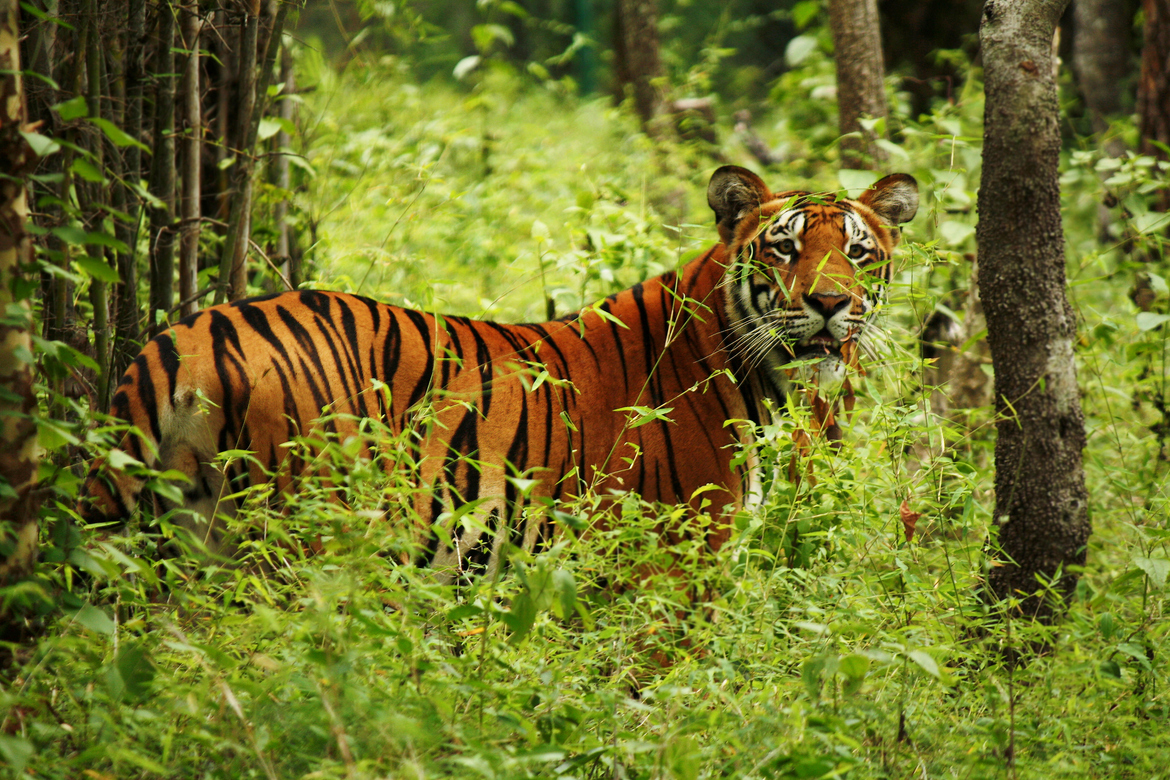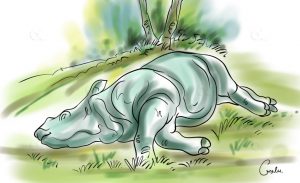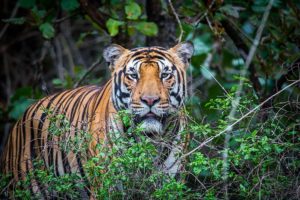I heard the driver say tiger, but he said it like he had seen a jackal. He didn’t slow down or go faster. Photo: Sagar Giri
Wisps of mist rose like incense smoke from the meditatively slow river. Across it, the jungle was still in a deep slumber. We waded barefoot, halfway up to the knees, stepping easily from a village into Bardia National Park, the largest protected area in Nepal’s lowlands.
Tulasi, the veteran jungle guide who was my chaperon for the day, did not take the crossing lightly. “We are now in a jungle,” he began as soon as I had put my shoes back on. His tone was ceremonious, like a teacher ushering in a new pupil at a gurukul, the Vedic school in which students lived with teachers in a forest hermitage. “There are tigers and rhinos and elephants here. It’s rare, but if we run into any of them, there are certain ways to protect ourselves. If it’s a tiger, never turn your back on it; stand tall and stare into its eyes, then walk backward, one step at a time. If a rhino charges you, hit it on its nose with a stick. There is only one way to escape an elephant: climbing a tree—a tall tree.”
Tulasi then handed me a four-foot-long staff, as though it was a rifle. I looked around. We were on a jeep track that bisected a grassland. The nearest trees were several hundred meters away, and they were all sal hardwoods, straight as Roman columns, their first limbs some thirty feet from the ground.
I processed the survival tips and our surrounding topography, and in my head, Tulasi’s spiel condensed to: Each man for himself when under attack from a wild animal.
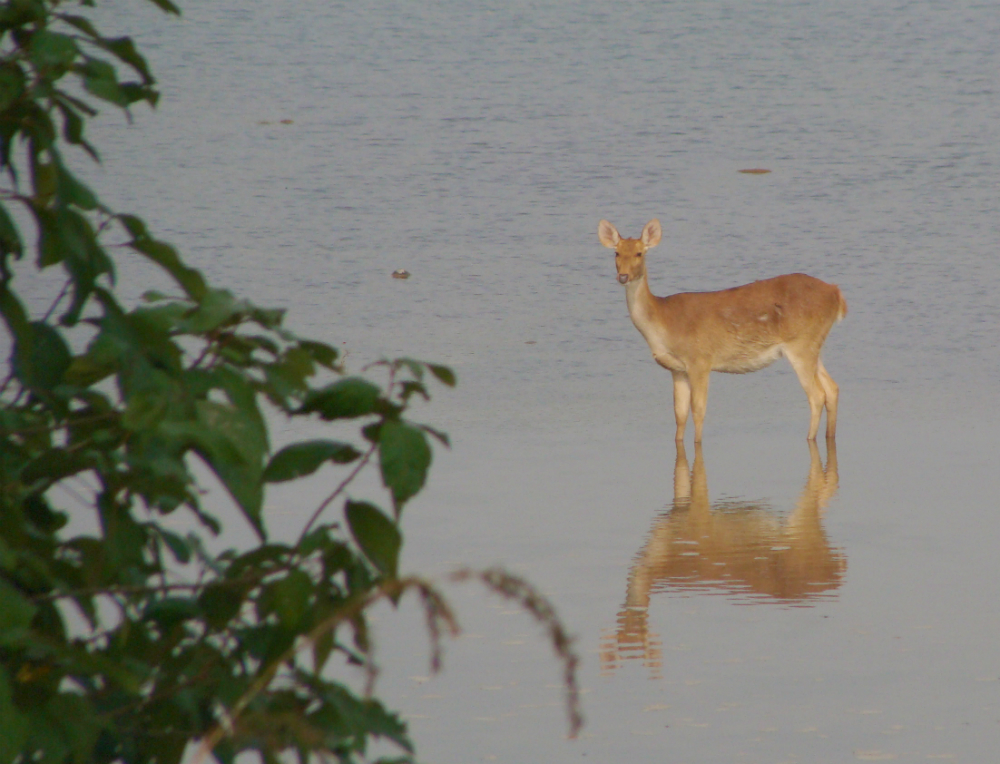
After the statutory pep talk, Tulasi turned onto a trail that passed through grass ten feet tall. I kept picturing a rhino or a tiger charging us around a corner. I tightened my grip on the stave Tulasi had given me. Of course, by then Tulasi was in tiger-showing mode, an avatar that guides in Bardia assume when in the jungle. In that mode, their desire to find a tiger is second only to a tiger seeking a partner during mating season.
As I walked behind the old-timer, I wondered what I had done to give him the impression that I was desperate to see a tiger. One of my happiest childhood memories is being in sal forests, to which my uncle and cousins occasionally took me when they went hunting. Those days of combing dappled jungles for quarry ceased abruptly when Maoist guerillas moved into the wilderness. But now, the rebellion over, I wanted to be among the ancient sals again. I harbored a faint hope of seeing a tiger, but it was never the reason for my coming to Bardia.

For Tulasi, a visit to Bardia was meaningless without a tiger sighting. At the time I was visiting, the tiger frenzy had spiked due to the sheer good luck of a Scot who was staying at the same resort as me. Tulasi worked there. The Scot had seen a tigress and her two adolescent cubs on his second day in the park. Tulasi told me that news the first time we met. His tone seemed to imply that it was now up to me to match the foreigner’s feat. He was asking me to rise above my tourist’s status; I was a Nepali first and foremost. A Nepali had to see at least one tiger.
The Scot, on the other hand, exulted around a campfire about the spiders on his room’s adobe walls and the mouse that made nocturnal visits to fossick in the empty potato chips packet under his bed. He mentioned tigers almost as an afterthought. “This place is what Scotland must have been like two centuries ago,” he mused, delighted at having traveled back in time.
Our march ended on the high bank of a sluggish stream. A noticeably worn out spot turned out to be the coveted hideout we had walked like crazy to get to before others. The place was called Tinkuné, literally ‘three corners.’ The view – the confluence of two almost stagnant streams – was hardly worth sitting for hours on the buttock-numbingly cold sand.
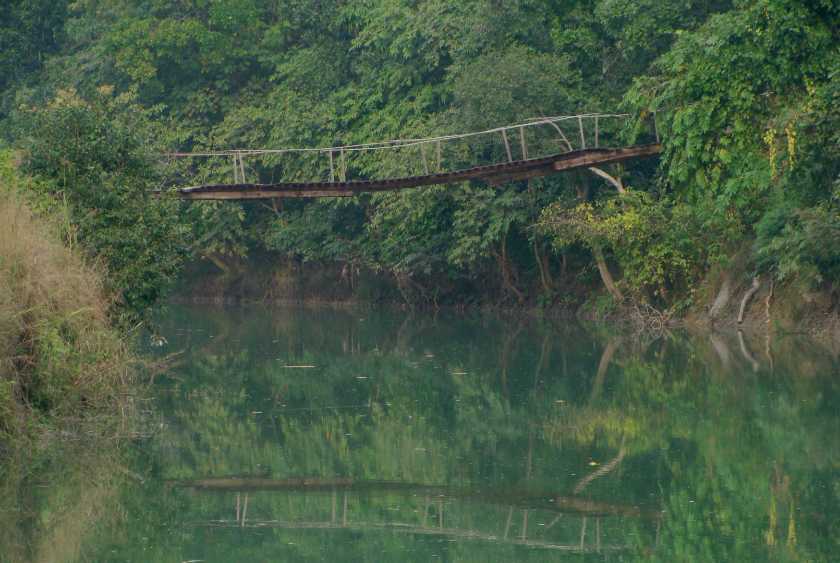
But Tinkuné was a promise, not instant gratification. Across the second stream, behind a belt of trees, was a large phanta, a grassland. The place was tailor-made for a tiger: the tall grass provided cover to hunt and eat in, and the stream was its water cooler. On our side, a screen of drooping branches gave humans a slight chance against the jungle folks’ superior senses. All we had to do was stay hidden, keep still and quiet and, with a bit of luck, we’d see a Panthera tigris.
It took more than luck to see a tiger, however. You needed to be as still, as camouflaged and as quiet as a tiger stalking prey—qualities that were Tulasi’s second nature. He could sit stock-still, eyes scanning the landscape, for well over an hour at a time. He barely spoke when in the jungle; outside, he couldn’t stop talking. Occasionally, he sprinkled anecdotes of tiger sightings into the simmering silence, as though to make it more palatable. “Only last year I was with a gori [white woman] from England. She had a huge camera. We were sitting right here when from nowhere a tigress and her cubs walked out on to the bank there” – he pointed to a sandbar across the stream – “The gori took dozens of photos. She even gave me one. It hangs in my house.”
The recounting irritated me. I had begun to covet a tiger sighting.
Waiting – suffering – in the hideouts had its rewards, but I, hungry for a tiger, never fully appreciated the beauty of those moments at the time. Across the stream a rhino sauntered along the bank, sampling the grass. Spotted deer and hog deer browsed peacefully, their composure itself a clue that no tiger was near. In one place there was a sinuous mark on the wet mud—the bodywork of a python. Also in attendance was a match made on the Mongolian steppe—a Ruddy Shelduck pair, conversing in sonorous honks. And sunlight glinted off a Smooth-coated River Otter as it suddenly surfaced.
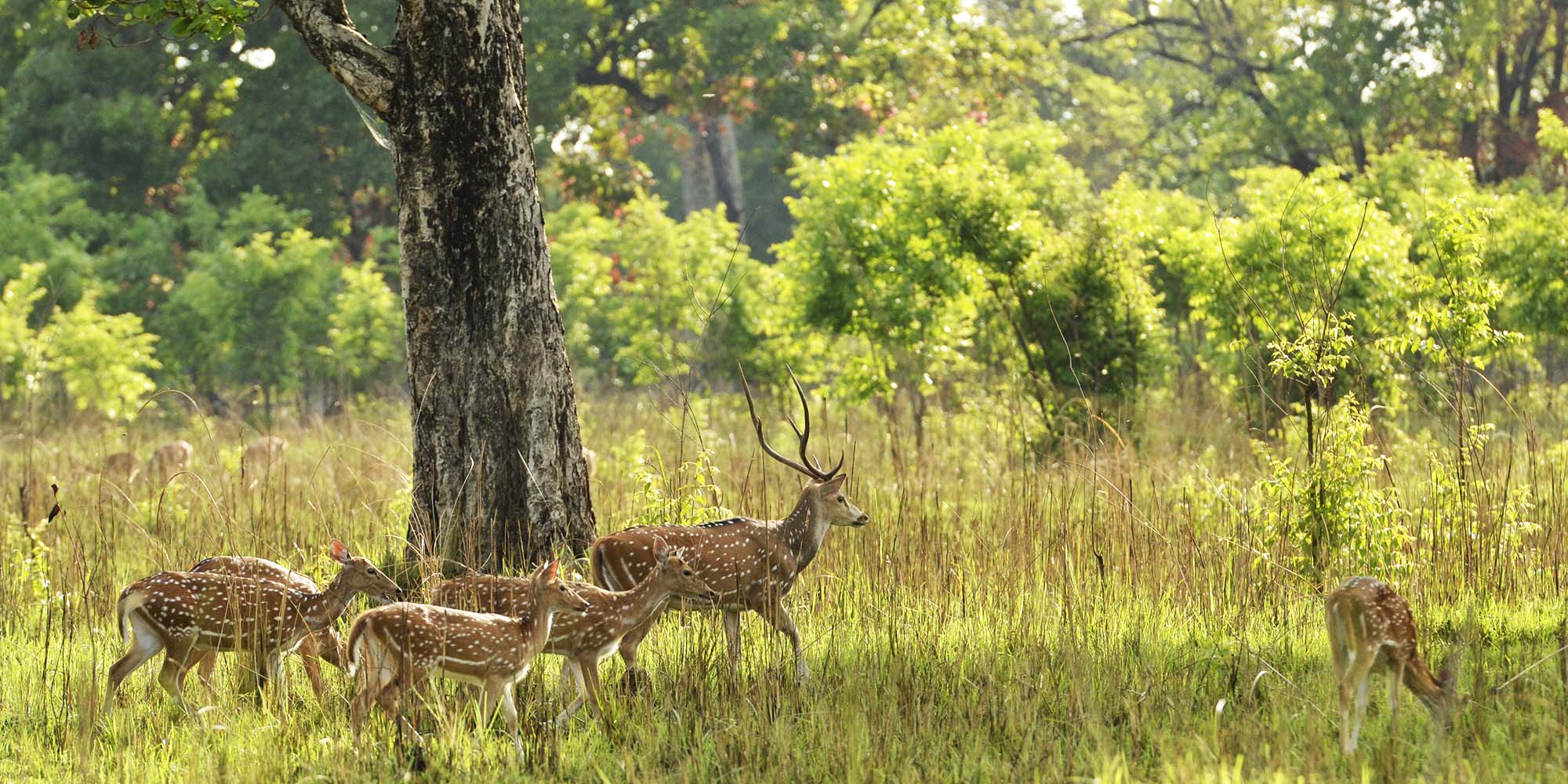
Tulasi sat beside me, an old sage taking in the scene before his eyes, ready to whisper a morsel of jungle wisdom.
One afternoon, as we sat scanning the banks, an elephant descended to the stream some hundred and fifty yards from us. One by one, dozens more appeared. A large bull elephant with tusks that were National Geographic cover material trundled down to the stream and stopped right in the middle. He stood there for the next twenty minutes as his herd, from cows with little calves at their heels to dilly-dallying adolescents, crossed over to the forest on the other side. It was a scene from a textbook on a family.
Tulasi told me I was very lucky to see such a large herd—29 in all. Bardia’s wild elephant population is a shadow of what it once was. Encouraged by the government’s quelling of malaria in the Terai, thousands of people migrated from the hills to the fertile lowlands in the 1960s. Axes swung and great swathes of prime elephant habitat vanished. Pachyderm numbers tumbled.
Bardia’s elephants have lost a lot to humans, but once in a while, they get one over them. Like on the day before we had seen the herd. We were in Bagh Machan, a fifty-foot high wooden tower, breakfasting on hard-boiled eggs and flatbread when two men came riding upon an elephant. Tulasi knew them. They were employees of a high-end park resort. One of their female elephants had eloped the night before with a wild bull. The mahouts were out to find her. The scene encapsulated Bardia beautifully: the wildness and vastness of the place, human encroachment on it and their follies, and sweetest of all, the urge to mate, if not love, triumphing.
The Bardia guides’ obsession to see wild animals resembled the paparazzi’s thirst for celebrities. Whenever two guides met – in a hideout, on a trail in the jungle, at the park’s entrance gate or in the village teashop – they asked each other about animal sightings.
What did you see? When? Where? Never an inquiry about the other man’s family, the preamble to the Nepali Book of Conversation. I felt sorry for their families. If thinking more about another creature than one’s wife is betrayal, then Bardia’s guides were lost cases. Above their bedposts would be a framed photo of a tigress; below it a guide snoozing, dreaming of his next sighting of the striped beauty.
Of course, that was a harsh way of looking at a guide’s professionalism.The truth was that guides in Bardia depended so much on the wildlife to sustain their lives that they had become non-participant members of the ecosystem. On days he was guiding, the fifty-five-year-old Tulasi got up at four in the morning, sometimes walked nearly twenty kilometers in the sapping heat, and sat patiently for hours.
Not to mention the risks of being a jungle guide. He did all this to feed his family, to send his sons to colleges in Kathmandu. If he was obsessed with a tiger it was for me, although his zeal made me wonder at times if he was also trying to surpass a local record for most tiger sightings.

The day after we’d seen the elephant herd, Tulasi suggested we take turns sleeping while we waited in the hideout. I was first. I lay on the warm sand, rested my head on a log, and fell asleep. Shortly after, Tulasi shook me awake. He put a finger to his lips to signal me to remain silent, then pointed to the stream. I thought only a tiger would warrant such a stress on silence. I rose slowly and peered over the bush. A swamp deer stood in the middle of the stream, motionless, neck erect, ears cocked, ready to bolt at the slightest sound. The stillness of the moment deepened her beauty. But I wasn’t too impressed. I was under the spell of the tiger: beauty to me was whiskers, stripes, and paws.
Tulasi and I tried for several days to see a tiger. We walked for hours to get from one location known for tiger sightings to another and spent hours in hideouts. We even took a break and went to see Nepal’s last wild herd of blackbucks, which had gotten so used to humans that they let people get to within thirty feet of them before sauntering away toward a couple munching on peanuts. But we didn’t see a tiger. After three days of waiting for a tiger, I ran out of patience. I decided to leave. Tulasi suggested I return in spring. He assured me I would see a tiger then.
A year after the last time sitting in the hideout with Tulasi, I was on a bus cruising on the highway that goes through Bardia National Park.
I heard the driver say tiger, but he said it like he had seen a jackal. He didn’t slow down or go faster. I looked out the window and saw a large tiger. He looked back at the bus as we passed by. There was none of the legendary fieriness in his eyes, only a haggard look that was perhaps a feline sigh.
Inside the bus, safe and detached, I felt no excitement. No heart-thumping, no adrenaline rush. I understood the lack of emotion in the driver’s voice. Both he and I had only seen the tiger’s body. The bus was too fast, too detached, too safe to allow us to get a feel for its spirit.
***
Places to stay
Thakurdwara, the village at the doorstep of the Bardia National Park, is one of the fastest growing areas in terms of hotels and guesthouses. You will be spoiled for choices there. Here are some recommendations:
Tharu Home Resort
As the name suggests, this place is built and decorated to resemble a traditional Tharu home, complete with finger-painted animal figurines on the facades of huts. It combines the traditional and the modern to provide a comfortable stay in the midst of nature. The place is solar powered, so guests don’t plunge into darkness with Thakurdwara’s frequent power outages. Rooms start at 1000 rupees a night.
Attractions: a pier extending into the canal in front of the hotel makes an idyllic spot to unwind at the end of a sapping day in the jungle. The Tharu cuisine here is delicious.
Contact: 9848022906 (Mohan Chaudhary); www.tharuhomeresort.com
Bardia Eco Lodge
In terms of leaving carbon footprints, a stay at this place is like gliding over the ground. This lodge takes environment-friendly practice to new heights. They even have compost toilets! Not that they have only given thought to being green. Their rooms are minimalist delights, with traditional Tharu décor. Even if you don’t stay there, their dining hall is worth a visit for their collection of Tharu household articles.
Attractions: secluded location, situated along a river. The bar on the first floor of their dining hall has a wonderful view of the river, where sometimes animals come to drink.
Contact: 9848237634 (Madhu Tharu); www.bardiaecolodge.com
Anjali Dolphin Resort
The name is almost an attempt to camouflage the exquisite taste of the owner of this resort. Everything – from straw mats to the bed sheets to the dustbins – in the small cottages here are designed and woven by Tharu craftsmen. The walls and floors are adobe, done like the interiors of Tharu houses. There is nothing traditional about the bathrooms, whose fittings would rival any luxury hotels of Kathmandu. The resort is owned by a Frenchman, and he lets it be known through his dining room, which is decorated beautifully, down to the plates with Maithali paintings and custom-made cutlery.
Contact: 9815555900/084-402080; [email protected]





